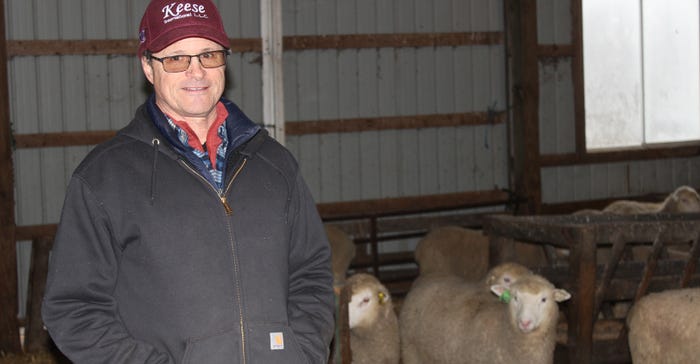
For sheep producers with flocks on pasture, controlling internal parasites can be expensive and time-consuming, but the cost of not controlling the parasites can be even greater, in reduced performance and death losses. While it won’t eliminate the need to monitor and deworm entirely, building a flock with greater genetic resistance can help reduce losses and treatment expenses.
John Anderson, who raises Polypay sheep seedstock near Shreve,in Wayne County, Ohio, has been selectively breeding for parasite resistance for 10 years, and he’s seeing the benefits in his own flock and in the breeding stock he sells.
Animals with better genetic resistance shed fewer parasite eggs in their manure after they’re challenged with parasites, he explains. By testing fecal samples, he can identify lambs with better resistance and determine estimated breeding values (EBVs) for the resistance trait. At the same time, he’s selecting for other traits such as muscling, growth rate and milk production. “You’ve got to look at the whole package,” he explains.
Anderson uses the National Sheep Improvement Program’s EBV system to record data on his lambs including birth weights, weaning weights and postweaning weights, as well as fecal egg count scores. His information is fed into the program’s database, analyzed and compared with data from other flocks to establish EBVs for animals in his flock. For instance, he recently sold a ram with a PWEC (fecal egg count) EBV of −77, putting this ram in the top 1% of the breed for parasite resistance.
Scheduled lambing
Currently, Anderson has a flock of about 90 ewes, and he follows a fall lambing schedule for most of his ewes. However, he breeds his fall-born ewe lambs for spring lambing. Like deer, their breeding cycle is dependent on day length; so for their first pregnancy, they do better with in-season breeding, he explains. “I’ll always have to lamb in the spring to get my ewe lambs started.” After that first in-season lambing, he can more easily get them on a fall lambing schedule.
Those spring-born lambs also give Anderson a chance to collect fecal egg count data. The lambs born in the fall do not spend much time on pasture, so they don’t have as much of a challenge from parasites. The spring lambs are on grass all summer, so they are exposed to more parasites, he explains. To collect useful data, the lambs in a study group need to be close in age and come from at least two different sires, so genetic differences can be compared.
If the timing works out, Anderson likes to get two fecal samples, one at weaning and another postweaning, to get as much data as possible. However, he also has to balance the well-being of the lambs.
All the lambs in a test group must be treated the same to get comparable data, he explains. Deworming has to be done after fecal samples are collected, and he can’t deworm one before the others if it’s showing signs of parasite stress. “It gets to be a challenge,” he notes. “You want to have enough of a load to get good data, but you don’t want them to get too anemic, either.”
Sampling, deworming processes
To decide when to pull samples and then deworm, Anderson uses the Faffa Malan Chart (FAMACHA) scoring method to estimate the blood loss from parasites by examining mucus membranes in the lambs’ eyelids. It’s important to carefully monitor FAMACHA scores, he notes. “That can change in a hurry.” For lambs, weaning causes stress that can make them more susceptible to parasites, he adds. For ewes, producing milk can increase stress and parasite susceptibility.
After he collects a fecal sample, he bags it with air excluded and stores it on ice to prevent eggs in the sample from hatching. Anderson sends his samples to a lab at Louisiana State University for analysis, and he gets results back in a couple weeks.
Data from Anderson’s flock, Lambshire Polypays, is compiled along with data from other producers around the country to establish EBVs for parasite resistance. That’s something many sheep producers are looking for, particularly if they are in the Eastern or Southern parts of the country and raising sheep on pasture, Anderson says. Resistance reduces the time and cost needed for deworming and improves feed efficiency. The resistance trait is not as important for producers in the West on drier rangeland, where parasites aren’t as prevalent. It’s also not critical for producers who aren’t using pasture. “Some of them don’t care because their lambs are in confinement,” he says.
As he makes selection decisions for his flock, Anderson starts with EBVs for parasite resistance, as well as other traits. For instance, since Polypays are used as a maternal line in the industry, he looks for milk production and good weaning weight EBVs to promote fast, early growth. However, too much postweaning growth can be correlated with mature body weights that are heavier than many producers want. “I look for a balance in these traits,” he says.
How a lamb looks is important, but EBVs offer more information about how the animal’s offspring are likely to turn out, Anderson adds. If lambs make the cut based on EBVs, he looks them over for disqualifying characteristics, such as lanky frames or bad feet, he explains. “But they’ve got to meet my selection criteria on paper first.”
Keck writes from Raymond, Ohio.
About the Author(s)
You May Also Like




